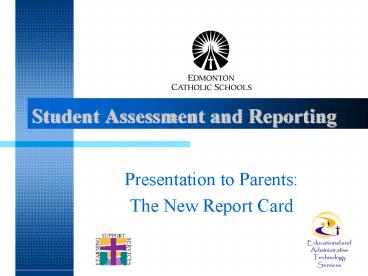Student Assessment and Reporting - PowerPoint PPT Presentation
1 / 18
Title:
Student Assessment and Reporting
Description:
Edmonton Catholic Schools developed the web-based report card over four years ... A report card is designed to summarize students' performance in school. ... – PowerPoint PPT presentation
Number of Views:40
Avg rating:3.0/5.0
Title: Student Assessment and Reporting
1
Student Assessment and Reporting
- Presentation to Parents
- The New Report Card
2
Background Information
- Edmonton Catholic Schools developed the web-based
report card over four years - Teachers provided valuable feedback on an ongoing
basis with respect to both technological and
pedagogical issues
3
The New Report Card
- Aligns with current research on assessment
practices - Provides specific and descriptive feedback on
student achievement - Communicates grade-level outcomes through key
learner outcomes which are completely aligned
with provincial programs
4
The New Report Card
- Shows the assessment level for each key learner
outcome selected - Includes separate information about a students
academic achievement, effort and growth as a
learner
5
Assessment of Learning
- A report card is designed to summarize students
performance in school. - The educators job is to make meaning of the
performances and to present facts, judgments,
diagnoses, and prescriptions in a concise,
user-friendly form. - Grant Wiggins
6
Growth as a Learner
- Social Development
- Works effectively with others
- Respects the property of self and others
- Accepts responsibility
- Plays cooperatively with others
- Demonstrates Christian involvement
- Work Study Habits
- Listens attentively
- Follows directions
- Demonstrates organizational skills
- Strives for quality in class work
- Completes assignments/projects
- Uses class time effectively
- Comments in this area describe social development
and work habits of the student.
7
Effort Levels
- Applies Extra Effort
- This range describes student engagement in class
activities and discussion that is exemplified by
a high degree of positive and meaningful
participation initiated voluntarily by the
student. These students are punctual in turning
in assignments and consistently go beyond the
stated requirements relative to neatness and
adherence to conventions. - Displays Effort Consistently
- This range describes student engagement in class
activities and discussion that is voluntarily
initiated by the student but more often initiated
upon request by the teacher. These students are
punctual in turning in assignments and meet the
stated requirements relative to neatness and
adherence to conventions. - Effort is Inconsistent
- This range describes student engagement in class
activities and discussion only when requested to
do so or when the request involves some sort of
gentle persuasion. These students are
inconsistent in turning in assignments or do not
meet the stated requirements relative to neatness
and adherence to conventions. Use of this code
suggests that the teacher will likely want to
discuss the students effort in the progress
report conference. - Requires more Effort
- This range describes student engagement in class
activities and discussion that is minimal or
non-existent. These students are not punctual in
turning in assignments and frequently do not meet
the stated requirements relative to neatness and
adherence to conventions. Use of this code
suggests that the teacher will likely want to
discuss the students effort in the progress
report conference.
8
Special Programs
- Adapted Programming
- The student is working at the enrolled
grade-appropriate learning outcomes with some
adjustments to the instructional program. The
student is not on an Individualized Program Plan
(IPP). - Adapted Programming with IPP
- The student is working at the enrolled
grade-appropriate learning outcomes with some
adjustments to the instructional program. The
student is on an Individualized Program Plan
(IPP). - Modified Programming with IPP
- The student is working with learning outcomes
significantly different than the
grade-appropriate curriculum. The student is on
an Individualized Program Plan (IPP).
9
Clarifying Terminology
- Formative assessment
- Provides information to students and teachers
about student learning and progress, and
direction for improvement and/or adjustment to a
program - Includes opportunities for practice and is not
part of an achievement grade - (adapted from OConnor,
2000)
10
Clarifying Terminology
- Summative assessment
- Provides information to students and teachers
about student achievement at the end of a period
of instruction - Is used to determine an achievement grade
11
Academic / Non-academic Factors
- A level of achievement does not directly measure
dispositions, effort, work and study habits, nor
good behaviour - The achievement level is based only on the
assessment evidence from the student, combined
with the teachers informed professional
judgment, based on the most recent information - Reporting on non-academic factors occurs
elsewhere on the report card (e.g. Effort, Growth
as a Learner, comment boxes)
12
New Levels of Achievement
13
Defining the Levels
- Demonstrates suggests that there is measurable
assessment evidence of student performance. - Achievement is a students demonstration of
knowledge, skills and attributes relative to
grade level curriculum standards.
14
Overall, the New Levels
- Describe the quality of performance
- Clearly connect to program outcomes
- Characterize a level of understanding of
subject-area content - Make evident a level of knowledge and skills
15
Aligning the Ranges
16
The Levels of Achievement
- Replace percentages and letter grades, to reflect
the variety of assessments teachers use (e.g.
rubrics, unit tests, checklists) - Are used to assess each key learner outcome and
there are no aggregate scores for each subject
17
Comments about Progress
- At each reporting period, teachers write
personalized comments for language arts,
mathematics and growth as a learner - All subjects can be commented on if desired
- Comments clarify where children are at
18
Final Thoughts
- Keep asking questions
- Read the newsletter inserts about assessment that
are sent home each month. - Know that were here to serve your children well.

